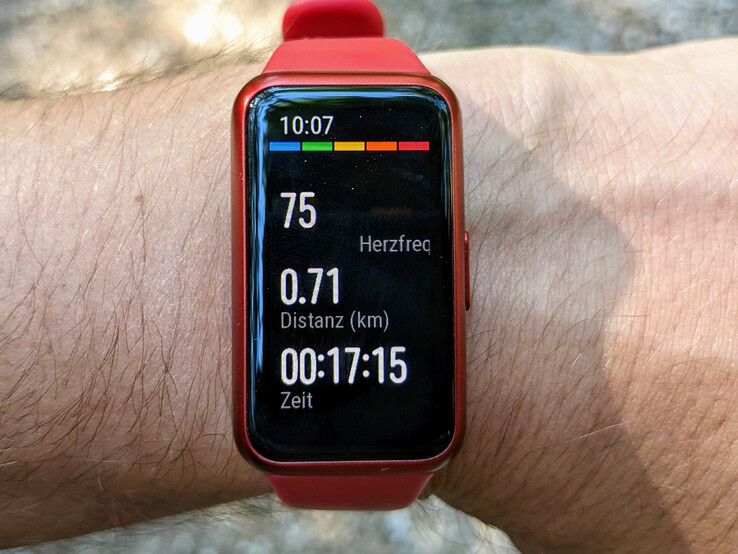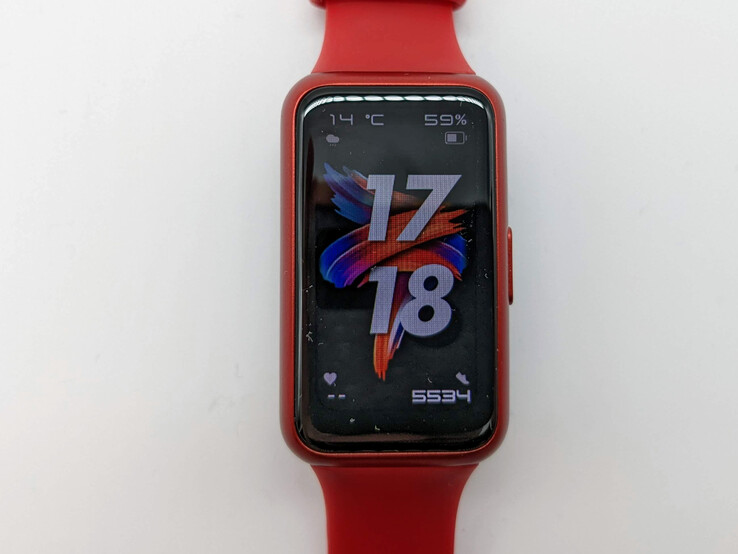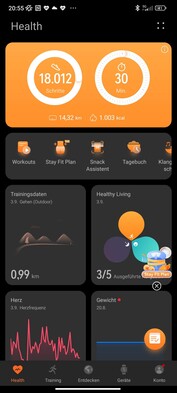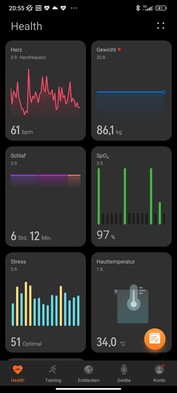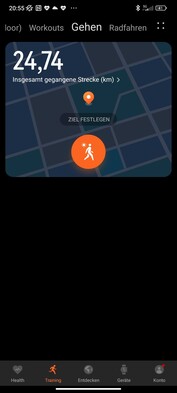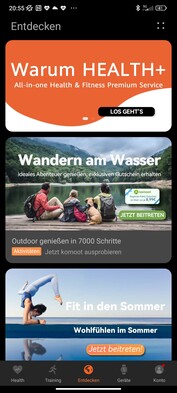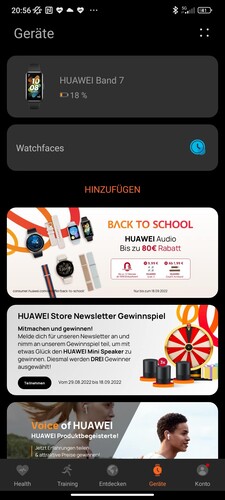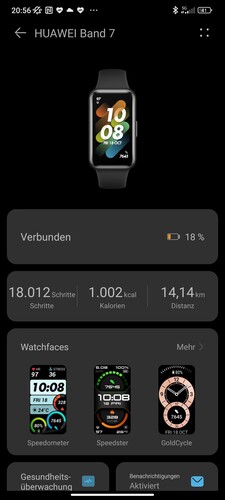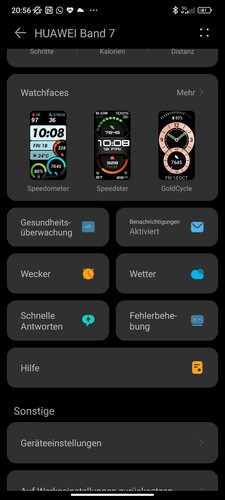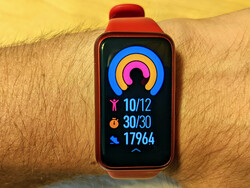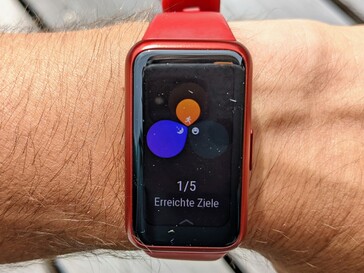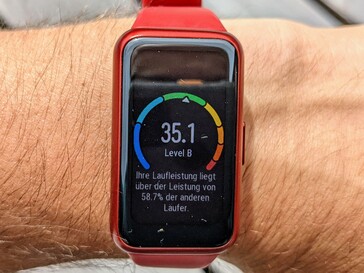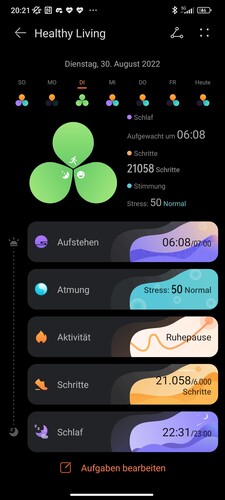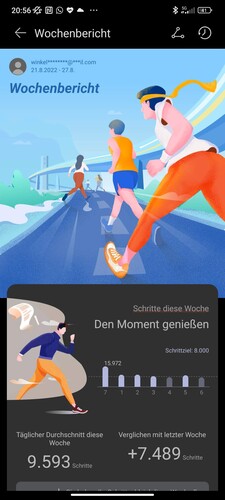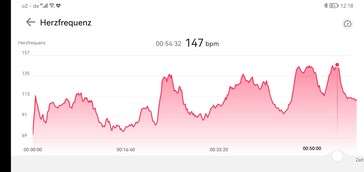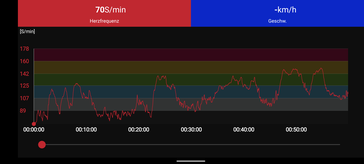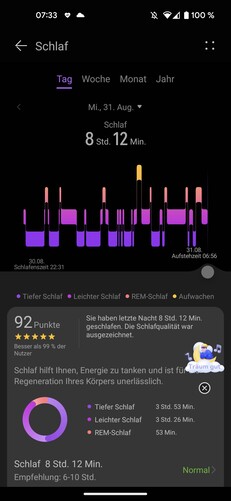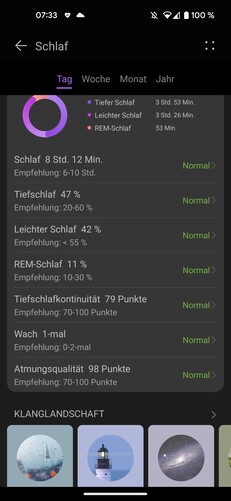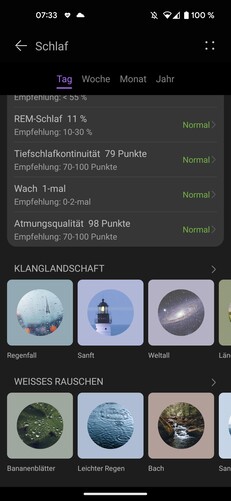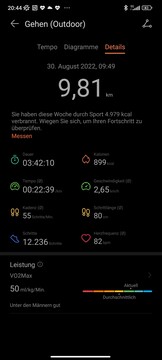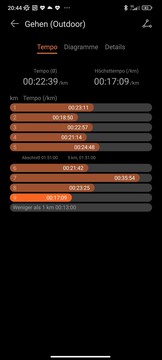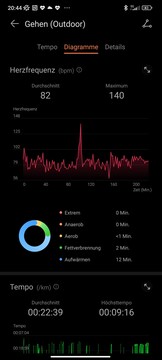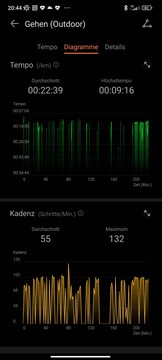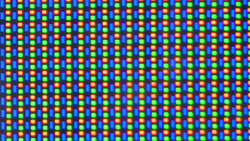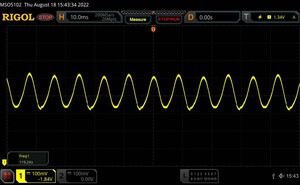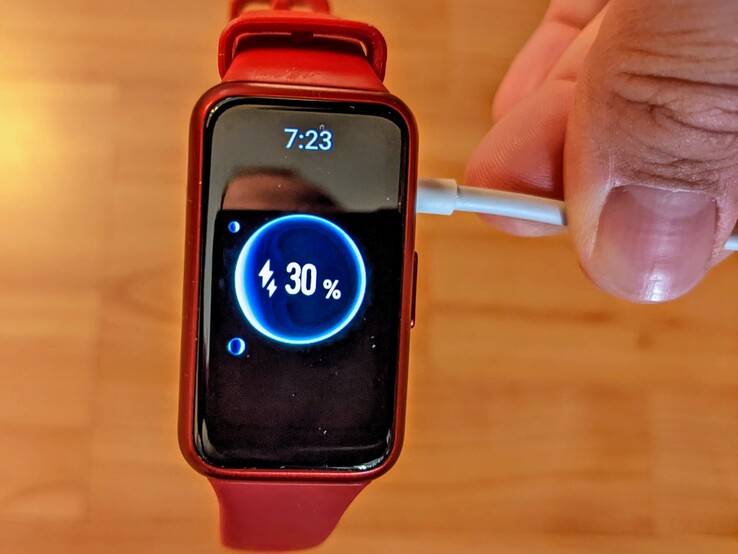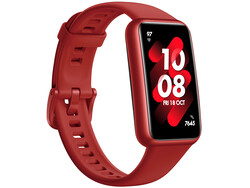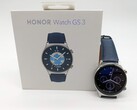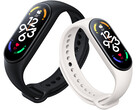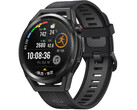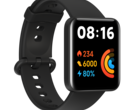Huawei Band 7 review - an inexpensive tracker that can do it all (almost)
The Huawei Band 7 is the entry point into Huawei's ecosystem of fitness trackers and smartwatches. The band is only available in one configuration, although in four colors: red, pink, green and black. The color choice applies not only to the armband, but also to the watch's case.
Equipment and case – a Huawei tracker with a light plastic case
The case of the Huawei Band 7 is made of fiberglass-reinforced plastic, which yields a minimal weight of only 17 grams (0.6 oz) without the band, which is one gram more than the manufacturer's specifications. With the silicone armband, the tracker weighs in at 29 grams (1 oz). The case sports a 1.47" OLED display, which is lightly curved on its long axis. Huawei has placed a button on the right side of the case, while the black underside houses several sensors for the heart rate and SpO2 monitors. Two metal charging pins can also be found on the underside of the device. The 16 mm (0.6") wide silicone armband has little levers on the springs and can be changed without any additional tools. The band is kept closed with a classic clasp, rather than a pin, as in the Xiaomi Smart Band. Huawei didn't build in a microphone or a speaker, and there's no LTE version with its own SIM card available.
Setup and operation - only possible through the Huawei Health app
The essential contact point here is the Huawei Health app, as the watch cannot be set up without it. All the data collected by the watch's sensors are also displayed and analyzed here. Due to US sanctions, however, the app can't actually be found in the Google Play Store, requiring a detour to Huawei's AppGallery. After the app is downloaded and you have approved installation from unknown sources, the Huawei Health app can finally be installed. Updates will happen automatically once the app has been installed. Some permissions must then be given to the software in order for the fitness tracker to be able to display messages and incoming phone calls. The Huawei Health app provides appropriate instructions depending on the manufacturer of your smartphone.
What is displayed on the band can mostly be set from the watch itself. You can switch between different watch faces and styles for the always-on display, for example, if these have been downloaded by the app beforehand. Aside from that, the content and order of the cards can be changed by swiping sideways from the home screen. The brightness settings are also handled directly on the watch. Huawei has not installed a built-in light sensor; instead, the user can switch between five levels of brightness and activate a mode for the watch's display to become darker at night.
The Huawei Band 7 is operated primarily through its 1.47" capacitive screen. From the home screen, a swipe from bottom to top opens up the notifications menu, where all incoming messages are displayed and sorted according to app. A swipe from top-to-bottom leads to the quick settings menu, with options for an alarm clock, do-not-disturb mode, smartphone search, as well as an option to activate the display for a few minutes. Sideways swipes lead through tiles with health information, such as pulse rate and blood oxygen saturation, as well as to tiles with the weather, currently playing media on the smartphone, and an overview tile with the usual circles for steps, active time and exercise time. The order and content of the tiles can also be customized by the user.
The Band 7 also has a button on the right that opens the app menu, where the individual applications are displayed as a list. Pressing this button while within an app always takes you back to the home screen, while a swipe from the left to the right edge takes one step back in each menu. The display can be activated both by lifting the watch up and by touching the panel. The Band 7 takes one second to light up its display when you lift it up to your wrist.
There are two widgets for the Health app, both of which provide an overview of steps taken, distance run, and burned calories. Clicking on the widget opens up the Health app.
Telephone and notifications - the Band 7 doesn't have telephone functionality
Given that the Huawei Band 7 lacks a microphone and speaker, telephone calls can't be made with this tracker. The wearable reliably displays notifications, while which apps can push notifications to the band is set through the Huawei Health app. Because the tracker doesn't have its own data connection, a paired smartphone has to always be within Bluetooth range. Although the band cannot display incoming images and emojis, the tracker has fixed short answers, and emojis can also be sent as replies from the watch. The order and content of the short replies can be adjusted via the smartphone app.
Voice assistant - missing from this Huawei smartband
The tracker doesn't have a voice assistant. Given that the essential microphone and speaker are both missing, this function can't be added later via a software update, either.
Health and fitness - lots of workout modes on the Band 7
The health parameters are displayed both on the watch itself and on the Health app. Next to the current values, the tracker also displays previous workouts. Even Huawei's well-known "Running Ability Index" feature has made it onto the Band 7. Through the use of a scale, the value of the wearer's performance during a jog is displayed and compared to those of other users. In addition, the tracker shows the last seven days' training regimen, the recovery status or estimated recovery time until the next intensive training session and the VO2Max. The tracker even calculates the times for certain distances, such as for a marathon. The band thus has extensive fitness features, most of which are intended for runners. The range of features is large, even if it doesn't quite reach the level of a Huawei Watch GT Runner, which collects even more information. Data synchronization with Google Fit is unfortunately not possible. However, Huawei is currently working on a way to synchronize the data with Strava, which should be implemented sometime later this year.
Activity goals - Huawei Healthy Living
The tracker provides a graphical overview of steps taken, movement time and active time. In a sub-menu, the smartband also provides the day's burned calories and distance traveled. The app goes into even greater detail, breaking down the steps into different categories such as running, walking and climbing.
The "Healthy Living" set of parameters, intended to ensure a healthy routine, goes further than pure activity tracking. In addition to steps taken and time active, stress levels as well as sleep and wake times are taken into account. The categories are displayed in different colors alongside their respective values, and the app can also remind the user of outstanding goals if desired. The band can also provide a notification if the user has not moved in a while, for example if they are sitting at a desk.
The Health app also offers the ability to create exercise and running plans, wherein personal preferences and performance are set, such as PR times and preferred exercise days. The app can then remind you of upcoming training sessions. The app also prepares weekly and monthly reports, where all data is marked and partly visualized. The data is also compared against previous exercise periods.
Heart rate, heart rhythm, and blood oxygen saturation
To better analyze the Huawei Band 7's heart rate readings, we compared them to a reference device, the Polar H10 chest strap. The tracker's resting heart rate deviates by 4.6%, while the active heart rate deviates by 3.37% according to three measurements. This makes the band significantly less accurate than Huawei's top model, the Watch GT 3 Pro, although it is significantly more accurate than the much more expensive Honor Watch GS 3.
We also compared the blood oxygen saturation values with a reference device, a Braun Pulse Oximeter 1. Three measurements gave an average deviation of 6.1%, with the watch's readings always lower than those of the reference device. This measurement is new to our testing procedure, so no comparisons to other devices could be made.
Sleep tracking - smart alarm clock feature missing from this Huawei
The Huawei Band 7's sleep tracking is convincing: the watch recognizes light, deep and REM-sleep phases, while wake times were reliably recorded during our test. The watch itself just displays how long the sleeping time was when you wake up; for the details, it's necessary to consult the Health app itself. There the various sleep phases are displayed graphically, while times and percentages are also provided. The entire sleep period as well as the individual phases are analyzed and the software then provides tips on how to improve sleep quality. Unfortunately, the watch doesn't utilize the sleep phase estimation for a smart alarm. The band can wake you up with its vibrating function, but only at set times and not according to the sleep phases.
Workouts get recorded automatically with the Band 7
The Huawei Band 7 supports the tracking of 96 different types of exercise, with six of these collecting more data or evaluating it more intensively, e.g. jogging or walking. Noticeably, outdoor cycling is missing from the collection. The tracker shows your pulse as a value as well as through a color scale during exercise. Additionally, you can track the distance, duration, burned calories, highest tempo, average speed, cadence, and stride length during walks. After set distances, such as after each kilometer or mile during a walk, the watch provides a summary of the last kilometer/mile and the training intensity is estimated.
The tracker can also recognize continuous movement if desired, and the display will ask if a workout recording should begin. This feature worked reliably during testing, although ten minutes of continuous movement was necessary for the question to pop up. The software accordingly asks whether a workout should be stopped if no movement has been detected for several minutes.
GPS and navigation - no connectivity for the smartband itself
The Huawei Band 7 doesn't have a GPS receiver and therefore can't establish a satellite connection. The tracker uses the Health app to connect to your phone's data.
Display - the crown jewel of the Band 7
The display is one of this Huawei tracker's great strengths. As is typical for OLED displays, the blacks are perfectly black and the contrast is great, even if the resolution is somewhat lesser than Huawei's smartwatches. The viewing angles of the tracker are also excellent: the sideways viewing angle is noticeably greater than in the vertical direction, due to the lightly bent glass in that direction. The one downside is the missing brightness sensor. This isn't such a big problem during the day, as the display is always legible even in the sun. In dark rooms, however, the display can be blinding, since the brightness isn't automatically reduced. The display managed to crank out a max brightness of 472 cd/m² in our tests, and we measured relatively constant pulse-width modulations at 120 Hz.
Screen Flickering / PWM (Pulse-Width Modulation)
| Screen flickering / PWM detected | 120.1 Hz | ||
The display backlight flickers at 120.1 Hz (worst case, e.g., utilizing PWM) . The frequency of 120.1 Hz is very low, so the flickering may cause eyestrain and headaches after extended use. In comparison: 53 % of all tested devices do not use PWM to dim the display. If PWM was detected, an average of 8327 (minimum: 5 - maximum: 343500) Hz was measured. | |||
Performance and runtime
Huawei doesn't provide any information on the built-in SoC or the memory. The device runs generally smoothly and stably, although there are slight delays when switching between individual tiles on the screen. Activating the display also usually takes a moment. The tracker is always responsive, although the performance isn't as smooth as by other, more expensive Huawei smartwatches.
Battery life - AoD drains the Huawei's battery
If all sensors and the always-on display are on and it is worn 24 hours a day, the Band 7 lasts three days and nights - without exercise tracking. If the always-on display is turned off, the mileage of the tracker goes up significantly to seven days and nights with the same use case scenario. The two weeks' worth of battery life promised by Huawei is only possible if the measurement frequency of the sensors is reduced. The device is charged via a charging cable with two metal contacts that magnetically attach to the underside of the watch. Charging from 10 to 100% takes 55 minutes.
Pros
Cons
Verdict - barely any limitations with this Huawei smartband
Huawei's Band 7 is a pleasant surprise, and it takes great advantage of the capabilities of the existing Huawei Health app. Particularly impressive is the good OLED display, which is always a joy to use. The tracker even has an always-on solution on board, even if the battery life suffers significantly with its use. The missing light sensor is disappointing but bearable.
Although the measured values of the health parameters are not exactly best-in-class, the Band 7 has nothing to be ashamed of here, particularly in comparison to other significantly more expensive smartwatches. Given the missing satellite connection and the inability to store any audio files, the watch has to be used in conjunction with a smartphone for most workouts.
Those who can do without the independent satellite connection, phone calls and a metal housing should take a closer look at this Huawei tracker.
Because the Band 7 provides a convincing performance on a daily basis with its reliable notifications, even short replies are possible. Another possibility would be the Xiaomi Smart Band 7, which falls in a similar price range. For a little extra money, the Redmi Watch 2 Lite offers a bigger display and a built-in satellite connection.
Price and availability
The MSRP for the Huawei Band 7 is 60€ ($60). At the time of writing, however, the device was also available at the manufacturer's website for 50€ ($50), with all four colors currently available. Other retailers, however, such as Amazon, also have the fitness tracker available.




